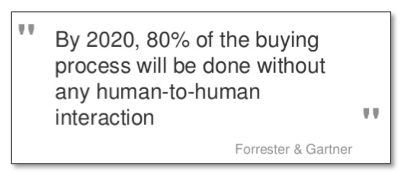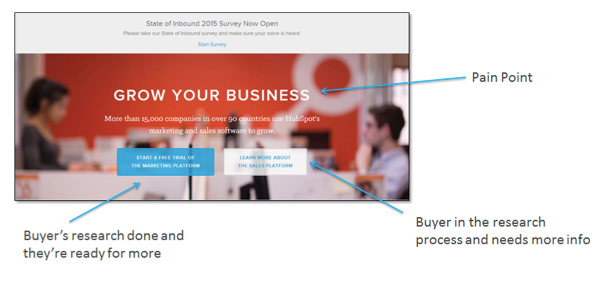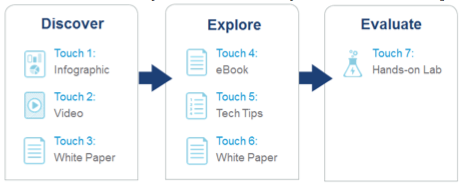Five seconds--that’s all the time your website has to make a great first impression on today’s tech savvy consumer.
August 31, 2015

Five seconds–that’s all the time your website has to make a great first impression on today’s tech savvy consumer.
By the way, that’s approximately the same amount of time it just took you to read the first sentence of this blog.
Quick, isn’t it?
We also need to consider the shift in the way today’s buyer approaches the sales process.
In a nutshell, the buyer’s journey has moved from a sales and demand gen process that was centered around a sales person sharing product information to a largely self-serve education process that begins with a simple keyword search.
As a result, buyers in the Internet age are far more educated than ever before, and they are now in the power position as navigators of the sales cycle. The majority of these decision makers also favor digital interactions over in-person meetings, so, by the time a sales representative engages with the buyer, a digital dialog has already begun and opinions have been formed.
 In fact, independent research by Gartner and Forrester suggests that 80% of the buying process will occur without any direct human-to-human interaction by the year 2020.
In fact, independent research by Gartner and Forrester suggests that 80% of the buying process will occur without any direct human-to-human interaction by the year 2020.
This makes your website and other online property (like LinkedIn, Twitter and microsites) critical to your sales process. Your website has to do the talking for you.
So, what should your website tell your buyers?
Long gone are the days of flowery mission statements and laundry lists of products and services. They’ve been replaced by the following must-have components that will surely capture the attention of today’s decision makers:
1. Understand your audience. This means more than identifying the companies you want to work with–developing a buyer’s persona of your ideal customer. Ask yourself:
What is their gender, age and job title?
Are they a decision maker or an influencer?
What is their typical buying cycle?
What pain points do they experience in their role across all aspects of their job?
Which pain points can my company solve? Choose navigation that speaks to your buyer.
Navigation on the home page should be set up to address the pain points of your buyer’s persona, by the vertical industries you support or by category of solutions you offer. For example, a mortgage company’s appeal to first time home owners is vastly different than if the potential buyer is refinancing or buying a second home.

Immediately address pain points and lead prospects down the path to a solution.
Here’s a great example of an effective home page. You can see that the pain point and need of the potential buyer are addressed front and center. The layout also offers two tracks for buyers to follow: one where they already completed the research phase and they’re ready to try (buy) and the other where they require more information.
Offer information for every phase of the buyer’s journey.
Give your site visitors the information they want–from a video or infographic for those who are just beginning to research a topic to an eBook, tech tips or even a hands-on lab for buyers who are ready to dive a little deeper. All of these easy-to- use assets are available free of charge to VMware partners via the Partner Demand Center. This platform also offers email and related landing pages, direct mail, telemarketing scripts, sales cheat sheets, social media copy blocks, and banner ads as part of our standard bill of materials for all campaigns
little deeper. All of these easy-to- use assets are available free of charge to VMware partners via the Partner Demand Center. This platform also offers email and related landing pages, direct mail, telemarketing scripts, sales cheat sheets, social media copy blocks, and banner ads as part of our standard bill of materials for all campaignsThe importance of Search Engine Optimization (SEO).
Remember those keyword searches we mentioned above? They are often the sole way many of your prospects find you online. And the key to being at the top of the search results is using keywords in URLs, pages and blog titles–and as many times as you can while still maintaining relevancy to the people looking at your site.Link to your social media platforms.
Current and potential customers are looking at you across the web, on your site and on social platforms. Having a social presence is important, and linking from your social platforms to your site and vice-versa, is expected by website visitors today. It also helps your SEO because search engines track social media referrals as part of their algorithms.
Want to see first-hand how to make your website talk to buyers?
VMware has partnered with Channel Maven Consulting to create an in-depth video to help you do just that. You can also find relevant assets and information via the Partner Demand Center that will keep your customers coming back to your site for more. We are also planning to develop additional campaigns with the buyer’s journey in mind – ultimately building a true multi-touch, digital relationship for our customers.
 Abigail Lee is Senior Global Partner, Marketing Manager, at VMware. Guest blogs such as this one are published monthly and are part of The VAR Guy’s annual platinum sponsorship.
Abigail Lee is Senior Global Partner, Marketing Manager, at VMware. Guest blogs such as this one are published monthly and are part of The VAR Guy’s annual platinum sponsorship.
About the Author(s)
You May Also Like


